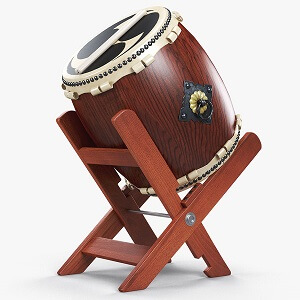Taiko
 In Japanese, taiko literally means "drum," though the term has also come to refer to the art of Japanese drumming, also known as kumi-daiko. Taiko has been a part of the Japanese culture for centuries. Centuries ago, taiko was used predominantly in the military arena. As it evolved, Japanese Buddhist and Shinto religions gradually began to take it on as a sacred instrument. Historically, it has existed in a multitude of other environments, including agrarian, theater, and the imperial court. The art of kumi-daiko, performance as an ensemble, originated post-war in Showa.
In Japanese, taiko literally means "drum," though the term has also come to refer to the art of Japanese drumming, also known as kumi-daiko. Taiko has been a part of the Japanese culture for centuries. Centuries ago, taiko was used predominantly in the military arena. As it evolved, Japanese Buddhist and Shinto religions gradually began to take it on as a sacred instrument. Historically, it has existed in a multitude of other environments, including agrarian, theater, and the imperial court. The art of kumi-daiko, performance as an ensemble, originated post-war in Showa.
North American taiko may also be attributed with developing the art of drumbuilding using wine barrels rather than carving them out of a single log. Because wine barrel-drums are cheaper and easier to build, taiko has become accessible to many more groups outside of Japan and aided the widespread growth of taiko throughout the world.
The first collegiate taiko group in North America was UCLA Kyodo Taiko, founded in 1990 by Mark Honda. Stanford Taiko and Jodaiko (UCI) followed in 1992. Since then, collegiate taiko has been one of the fastest growing taiko phenomenon in North America! In 1995, Stanford Taiko started the Intercollegiate Taiko Invitational, an annual event in which many collegiate groups come together for a weekend of workshops and performances. The event has grown rapidly in size since its inception; currently, around 300 collegiate taiko players attend every year!